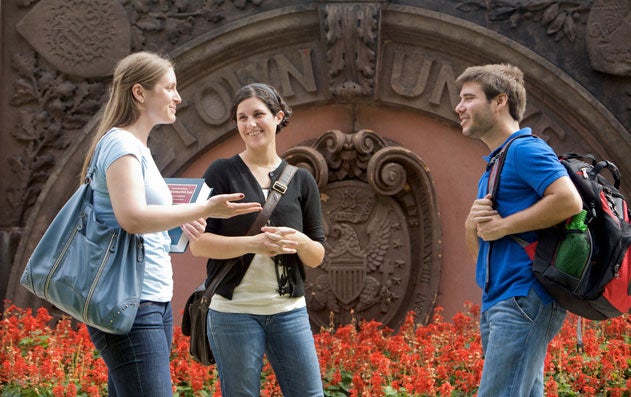Title: University Maintains Strong Financial Aid Commitment as Tuition Increases
Georgetown will increase its financial aid by $7.9 million for the 2014-2015 academic year with $4.4 million budgeted for undergraduate need-based support, while raising undergraduate tuition by 4.3 percent.

The university will continue to make investments in and out of the classroom for the 2014-2015 academic year, enhancing the student experience while maintaining a commitment to policies that ensure a Georgetown education to eligible students regardless of financial need.
Georgetown will increase its financial aid by $7.9 million for the 2014-2015 academic year, with $4.4 million budgeted for undergraduate need-based support, while raising undergraduate tuition by 4.3 percent.
While the cost of delivering higher education has risen, Georgetown has worked to control costs in order to continue making investments in the student experience. In only four years, the university strategically reduced the cost of attendance from the third highest in the nation to the 35th highest.
Commitment to Access
The total amount of financial aid for the next academic year is $161.6 million, with $105.7 million for undergraduates.
“We want to ensure we provide eligible students access to the highest quality education while maintaining our commitment to a racially, ethnically, economically and culturally diverse student body,” says President John J. DeGioia. “In this time of major disruptions in higher education, we are also investing in key areas of technology and experimentation and continuing work toward our vision of a more residential living-and-learning campus.”
Georgetown is one of only a few dozen colleges and universities – out of more than 4,700 institutions nationwide – that maintain need-blind admissions and full-need financial aid policies.
In place since the late 1970s, the policies meet the full need of eligible students –regardless of their ability to pay – through a combination of loans, grants and work-study.
Fundamental Commitments
“Our need-blind and meet-full-need policies are two of the most fundamental commitments we make as a university,” DeGioia says. “These two policies ensure that the very best students can attend Georgetown, and they result in a richness and diversity that makes our entire community stronger.”
Nearly 40 percent of the undergraduate student body is expected to receive need-based scholarship aid in 2014-15.
Tuition is rising, DeGioia says, to ensure that these policies stay in place while the university works to meet the new challenges facing higher education.
Technology and Innovation
As technology presents new opportunities for delivering education, Georgetown is making investments to enhance learning in the classroom.
The university was an early partner with edX, the online learning initiative founded by Harvard and MIT and has made an $8 million investment in the Georgetown Initiative on Technology-Enhanced Learning (ITEL). These grants support faculty innovation in the classroom, exploring how best toenhance the experience of teaching and learning at Georgetown through technology.
The university also recently launched an integrative initiative called Designing the Future(s) that explores these challenges and actively experiments with new ways to deliver a Georgetown education into thefuture.
Building on the endless opportunities of research based on massive data, the university recently launched a new McCourt School of Public Policy, a long-held vision that acknowledges the urgency of solving some of the most complex public policy challenges of our time.
Georgetown student interest in solving social problems is reflected in the university’s new Beeck Center for Social Impact & Innovation.
And in keeping with its vision to develop the historic Georgetown campus as an undergraduate-focused residential living-and-learning campus, Georgetown is also investing in the student experience, with a new residence hall and a new student center being built on campus.
Strong and Sound
All of these investments have taken place in a cost-controlling environment across all campuses to ensure that Georgetown remains a top student-centered, research university.
“Our financial plan is crafted to place our university in a strong and sound position,” DeGioia says, “so that we can continue to fulfill our most fundamental commitments to our community and also make the necessary investments to ensure our competitiveness into the future.”
Undergraduate tuition for the academic beginning in the fall of 2014 will be $46,200, from $44,280 in 2013-14.
Room charges for the 2014-15 academic year will go up by 2.3 percent and board charges by 4.3 percent. The total cost of undergraduate tuition, fees and average room and board for the next academic year will be $60,186, compared with a 2013-2014 cost of $57,868.
Tuition at the Graduate School of Arts and Sciences will rise 3.5 percent for the next academic year, with Georgetown Law tuition rising by 4.4 percent. Tuition and fees at the School of Medicine will rise by 3 percent.